Based on refractive index distribution, multimode fiber (MMF) can be classified into two categories; graded-index fiber and step-index fiber. Graded-index and step-index fiber have different operating principles and they are considered for different networking scenarios. Ahead in this post, we are going to discuss the differences between the two types of multimode fibers and their applications also.
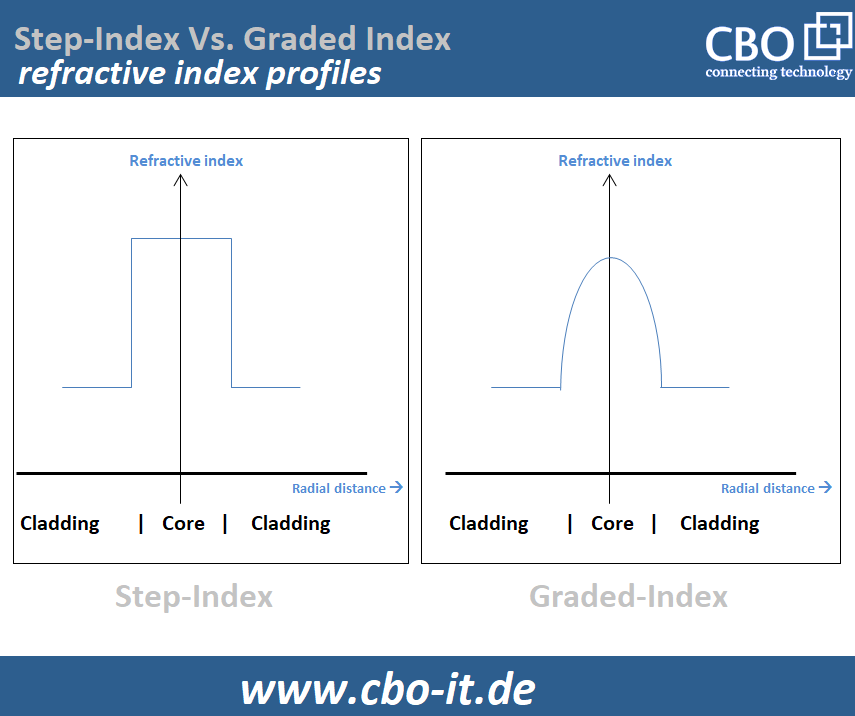
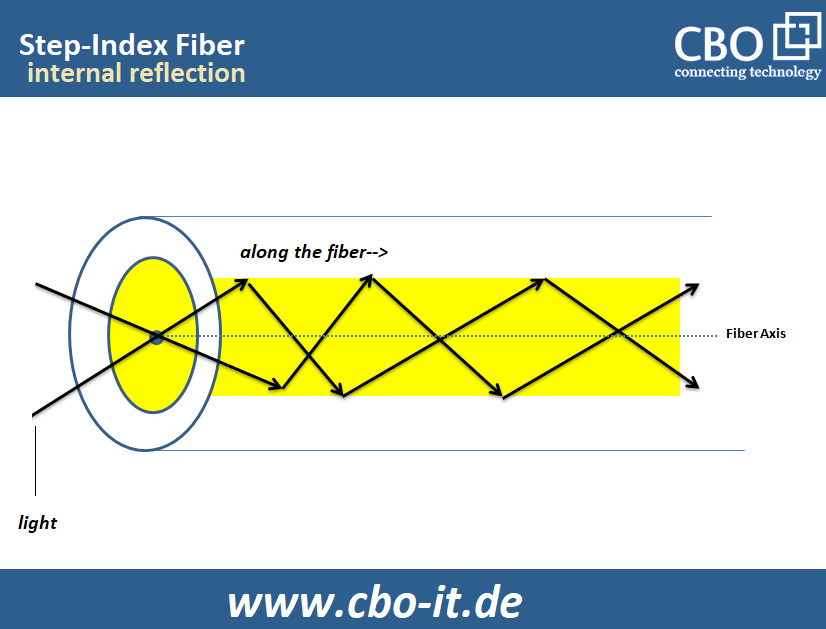
Step-Index Type Multimode Fiber (MMF)
In this type of fiber, a uniform index of refraction is maintained within the core. At the core-cladding interface, the refractive index value almost zeroes resulting in a sharp reflection of light beams. This poor refractive index at the core-cladding interface is a manifestation of cladding`s lower refractive index. Step-index multimode fibers operate on the principle of total reflection and allow traveling of light across the fiber/core axis in a zigzag pattern.
Light entering the step-index multimode fiber at different incidence angles will pass through different paths ensuring effective multimode operation. Each light beam travels at the same speed across the fiber however the time it takes to exit depends on the angle at which it entered. Beams entering at steeper angles will counter more reflection resulting in exiting later than the light beams entered at less steep angles.
Modal Dispersion in Step-Index MMF
As we have discussed above, in multimode fiber rays of light are introduces along the fiber axis with different angles. Rays entering with a shallower angle take a relatively direct path to reach the end of the fiber. On the other hand, rays introduce with sharp angles take more time to exit the fiber because of undergoing more reflection spells off the cladding/core boundaries. In multimode fibers, this distortion mechanism is represented by a phenomenon called Modal Dispersion or intermodal distortion.
In fiber optics-based, digital communications light pulses are used for the transmission of signals through the fiber. Modal dispersion causes the signals or pulses to spread in time because optical signals generated at different modes come with different propagation velocities. In multimode fibers the magnitude of pulse spread out depends upon the number of modes being transmitted. The available bandwidth of the step-index multimode fiber gets compromised if it is subjected to a higher number of modes. Modal dispersion tends to downgrade the performance of an optical fiber-based communication system because in case of extensive dispersion overlapping of pulses cannot be prevented resulting in alleviated bit error rate (BER) readings.
Step-Index Multimode Fiber Applications
It is quite evident from the earlier discussion that, step-index multimode fibers operate with higher dispersion. Fiber dispersion does not only affect the data transmission capability of the fiber but it also limits the maximum effective communication distance. Because of these limitations, the step-index multimode fiber is generally considered for low-speed and short-distance applications only. This type of fiber is more suited to applications where higher power densities are required such as industrial and medical power delivery. For data transmission and telecom graded-index fiber is preferred.
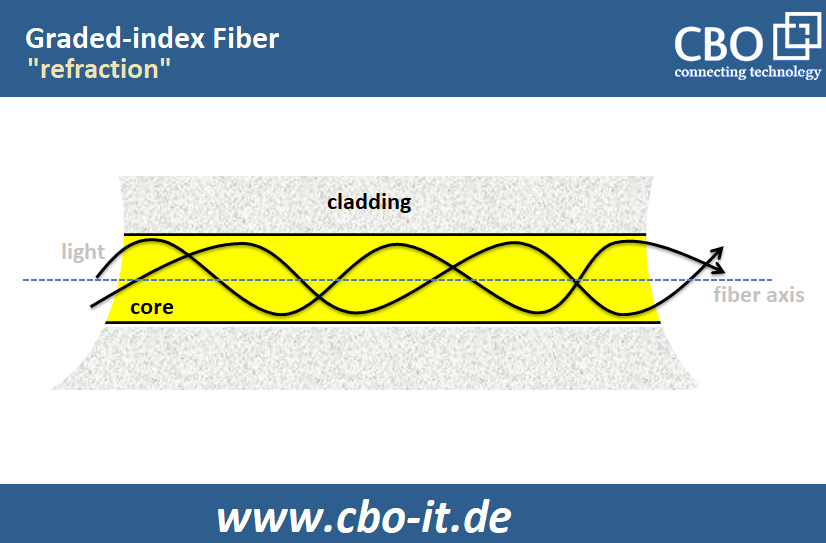
Graded-Index Type Multimode Fiber
In this type of fiber higher refractive index is maintained at the core axis and it decreases gradually as the radial distance (measured from the core center) increases. In short, the refractive index inside a graded-index fiber decrease away from its center and at the edge of its core refractive index value becomes almost equal to the refractive index value of the cladding. This gradual change in refractive index value results in internal refraction instead of reflection. Thus, the light rays bend towards the fiber axis as they move through low refractive index fiber. In graded-index type multimode fiber we see almost zero total internal reflection because light beams are forced back to the core axis before they strike the cladding. Following are a few notable properties of graded-index multimode fiber;
- Low loss
- High bandwidth
- Expansion capability
- Low sensitivity to macro-bending
- Low sensitivity to micro-bending
- Supports longer distances
Modal Dispersion in Graded-Index MMF
Modal dispersion is a common phenomenon related to multimode fiber applications where different light modes enter the fiber simultaneously but exit asynchronously. In graded-index multimode fibers, the effect of modal dispersion can significantly be reduced because the speed of light inside the core varies with the refractive index. Light traveling away from the core of the fiber improves in speed as the refractive index decreases gradually. This difference in speed compensates for the longer times taken by the light beams that traveled through longer paths. As a result, in graded-index multimode fibers, the transmission time of various modes remains almost identical resulting in a significant reduction of the model dispersion and making the fiber capable of operating at a higher bandwidth.
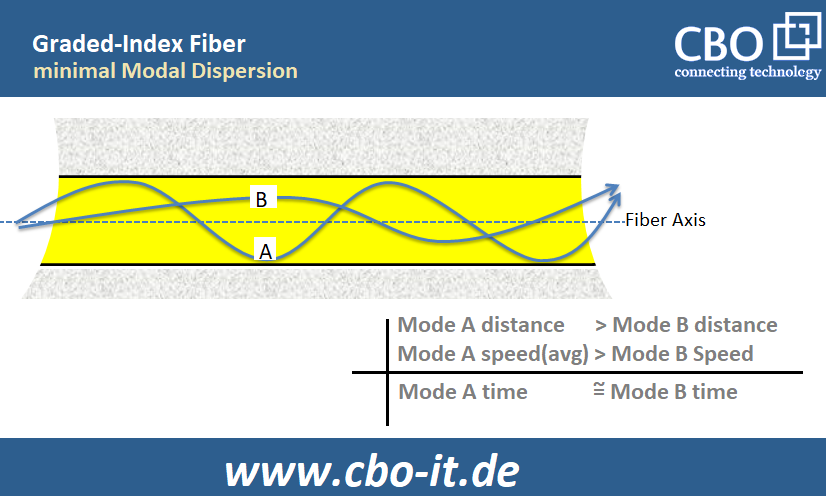
The figure above is showing that;
- Two light rays (mode A and mode B) entered the fiber with different angles of incidence
- Both light rays left the fiber at the same time, approximately.
- Mode A traveled through a longer path and covered more distance.
- Mode B traveled through a shorter route relatively.
- The longer distance covered by mode A got compensated by its higher average speed
- Low refractive index regions of the fiber enabled the mode A to achieve better speeds
- Mode B remained closer to the fiber axis and, that’s why it traveled at a lesser speed
Graded-Index Multimode Fiber Applications
Graded-Index MMF has evolved as a default choice for multimode optical fiber applications. Today, this type of fiber is being widely utilized in data transmission applications. This type of fiber is considered for high-speed (34 Mb/s to 140 Mb/s) and medium-distance (10km-20km) applications. Step-index fibers cannot handle that higher bandwidth and distance because of extensive model dispersion of internal distortion.
Which type of Multimode Fiber is Preferred?
Most present-day applications use graded-index when it comes to the preferred type of multimode fiber. Different manufacturers are producing different graded-index fiber grades. Here, it is important to understand that core and cladding size is two of the most important design parameters. Cables with different core and cladding size combinations are being manufactured today. However, the 62.5/125 fiber cable offers the best performance and can be considered for a variety of applications. On the other hand step-index, multimode fiber is considered for short-range, low-bandwidth applications only. In the following chart, you can see a quick comparison between the two types of multimode fibers.
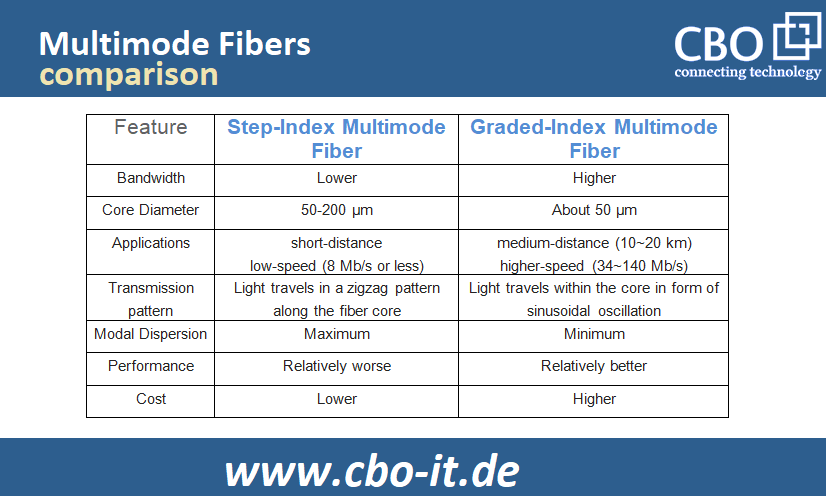
Conclusion
- Step-index fiber and graded-index fiber are two types of multimode fibers
- Graded-index fiber offers superior transmission quality, higher-bandwidth, and longer distance
- Higher modal dispersion limits the bandwidth of the step-index fiber
- In modern communication applications, graded-index fiber is preferred.
- Step-index fiber is cheaper but it cannot offer higher bandwidth nor longer distances
 English
English
 Deutsch
Deutsch
 Espaniol
Espaniol










